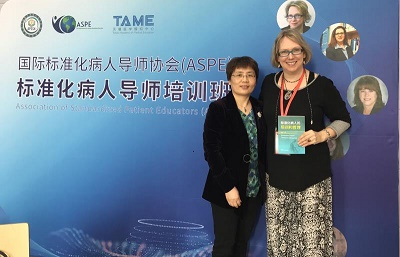Training Improves the Standardization and Professionalism of SPs - Reflections on the ASPE Courses in China
By: Shi Shuwen, Zhejiang University School of Medicine

In the nice spring time of Xiamen, I was very pleased to attend the ASPE courses from March 13th to 25th, 2019. The Train-the-Trainer course was held by Asia-Pacific Society for Simulation in Healthcare (APSSH), Xiamen Medical College and the Association of Standardized Patient Educators (ASPE). I benefited a lot from the three courses. I learned many strategies and skills in the practice of running an SP program, and I have a better understanding on the Standards of Best Practice (SOBP).

A Standardized Patient is an individual trained to portray a medical patient in a realistic way, who can also be trained to evaluate trainees and provide feedback. The standardization of SPs refers to the standardization of an individual to consistently portray the same case many times, and refers to the standardization among different SPs to accurately portray the same case. SPs increasingly play more important roles in the teaching and assessment of clinical skills.
How can we make SPs more standardized and professional? Through standardized and systematic training!
Who will train the SPs? The SP educators! Well-trained SP educators ensure the quality of the SP program.
The workshops provided us many opportunities to discuss and practice new concepts, which made us fully involved in the course activities. The courses were facilitated by Recognized SP Educators (RSPEs) from China and the US, with a combination of on-site training and online lectures. Valerie L. Fulmer, the President of ASPE and Director of the Standardized Patient Program at University of Pittsburgh School of Medicine (UPSOM) gave us the on-site training. Karen Lewis, the former President of ASPE and Dena Higbee, the Vice President of Finance for ASPE and Director of Shelden Clinical Simulation Center at University of Missouri gave us the online lectures. The experts fully explained the origin of the SOBP, and the five domains and core values. The five domains include Safe Work Environment, Case Development, SP Training, Program Management, and Professional Development. The five values include Safety, Quality, Professionalism, Accountability and Collaboration. We learned the SP methodology and the experience of running an SP program in the US, including the practices at UPSOM and Shelden Clinical Simulation Center at University of Missouri. The Chinese RSPEs gave us lectures and provided additional learning opportunities without the language barrier. We discussed and shared ideas on the domestic SP program development in the course and we learned a lot from each other.
The SP program started at Zhejiang University School of Medicine with the support of China Medical Board of New York (CMB) in 1991. I have been working on SP training and management for 10 years and I wrote the book Standardized Patient Training and Management which was published by Zhejiang University Press in 2017. The ASPE courses provided new skills and methods which are very useful in the practice. I will use the strategies I learned from the course in the future and train the SPs in my program in a more standardized way, thus improving the teaching and assessment of medical students’ clinical skills. Here are what I learned from the courses:
In Course 01, I learned to write objectives for a formative case, write a case using the ASPE case template, train SPs for role-portrayal and feedback, and how to give feedback to SPs as an SP educator.
There are four components of an objective, namely, who, what, when, and how much. We should always remember: Begin with the End in Mind!
The ASPE case template is well-organized with useful details. In my opinion, we may change some details according to our practice. For example, Part I Administrative Details and Part III Content for SPs could be integrated or written in a whole paragraph to make it more readable.
In the SP role-portrayal part, ASPE SOBP emphasizes that sending SPs into learning experiences without adequate training can compromise both the effectiveness of the learning objectives and the safety of everyone involved. The role of the SP Educator is to teach SPs the skill of translating the information contained in a written scenario into observable behaviors that SPs demonstrate through their role portrayal. I cannot agree more on this point. We should abide by the three principles of SP training:
- Preparing for the training session; This is the key to successful training sessions.
- Leading the training session; The SP educators apply different strategies to engage SPs in the experiential learning of role portrayal.
- Reflecting on the training session. The reflection and group discussions lead to review on the expectation and what needs to be improved.
Feedback is information conveyed by the Standardized Patient (SP) to a learner about the learner’s behaviors, and how those behaviors affected the SP. The feedback should be observable, specific and clear, and should not be based on assumptions. There are five steps of a feedback process:
- SP observes learner behavior and remembers strengths and areas for improvement. I think this is the most important part since any effective feedbacks should be based on this.
- SP “comes out of role” and initiates the feedback session. SP also needs to ask whether the student is ready for feedback or not.
- SP asks the learner how the session went.
- SP responds to the learner and provides feedback from SP point of view. In this part, SPs should be trained to use the “I statement”, which is different from my own practice previously. I used to train the SPs to give feedback from the third person perspective. By the end of this workshop, I realized that using an “I statement” is a better way for the SP to express the feelings of patients, which is more realistic and encourages the student to focus on the patient-centered encounter. In the class, we also discussed on feedback techniques such as the “Sandwich Technique” and “Ask-Tell-Ask”. Either technique is appropriate. The Sandwich Technique is usually preferred when someone is new to giving feedback. Ask-Tell Ask is more conversational and usually requires more feedback experience.
- SP asks the leaner how he/she will incorporate the discussion into future patient encounters. This part is very necessary since it ensures the student has realized what he/she should do better in the future.
In the last workshop, we learned the skills of giving feedback to SPs’ performance and feedback. I will continue to use the SP Performance and SP Feedback forms in my work in the future.
In Course 02, I learned to write summative cases and checklists, and train SPs for summative exams. Writing a summative case is more complicated than writing a formative one, and a higher level of standardization is required in SP training.
Before writing a summative case and checklist, a case development committee should be established. An ideal committee includes Content Experts (Basic Science, Clinical, SP, etc.), Process Experts (SPE, Technology), Educational Specialists, and Course/Examination Organizers. A good summative case should meet the expectations of assessment (validity), ensure the SP can reliably reproduce the case for several learners (reproducibility), ensure the accuracy and consistency of role-portrayal and assessment of the SPs (standardization), and ensure every student have a reasonable chance to succeed (fairness). The validity and fairness are specifically required in the checklist design of a summative case.
In the workshop of training the SPs for summative cases, I learned many useful training strategies and techniques to help the SP educators ensure standardization of SPs for role portrayal and checklist completion. What’s more, the trail run of the case is necessary, since problems can be found and corrected in this process. Otherwise, the validity of the actual examination may be affected.
In Course 03, I learned to document policies and procedures for an SP program, including the recruitment and interview process for new SPs. This course provided us very practical skills in program management. Although I have been working for the SP program at my institution for 10 years, I still learned many new ideas and strategies from the course.
The entire workshop lasted for two weeks, but I think it is worthy to take such a long time to learn the ASPE SOBP in a systematic way. The theory and practice of the courses is helpful to for those without experience who are starting a new program, or to improve our work for those with experience. The courses also provide us an international perspective of development of SP methodologies.


Publications Committee Mission: “To bring high quality reporting of current research, trends, techniques and information regarding SP methodology and other relevant industry articles to the attention of the membership through the web-based ASPE eNews blog.”
Please provide comments, questions or suggestions about the ASPE eNews Blog here.
